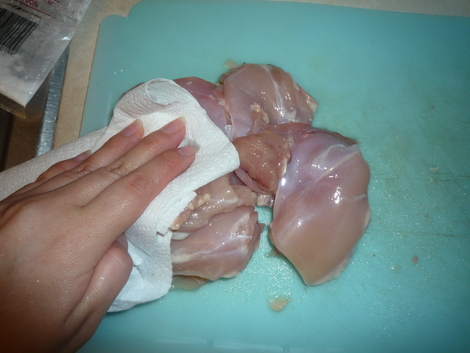Who doesn’t like fried chicken? Japanese fried chicken or Chicken Karaage differs somewhat from the Colonel’s recipe. Japanese fried chicken is cut up into bite size pieces, well more like 2-3 bites per piece. It’s also flavored with soy sauce, sugar, sake and/or mirin. The main difference is in the batter, although there are many variations that call for the use of eggs, flour, potato and/or corn starch or a combination of these ingredients.
Chicken karaage is usually served as a teishoku (定食) which is like most of these build-a-meals and usually consist of rice, miso soup, a main dish and side dishes.
I have tested many recipes to get the perfect crispy batter and chicken that’s not dried out from deep frying too long. This is the result.
The most common recipe is using plain katakuriko (potato starch). I’ve strayed from this and used a combination of egg and katakuriko, but in my experience plain katakuriko works best.
The key to having a crispy batter and juicy chicken is to deep fry the chicken twice. The first time is to cook the chicken part way and you’ll want to let it rest so that it will stay moist. The second time you deep fry is to get the outside crispy so you’ll only need to fry it for a minute.
I hope you enjoy it.
Ingredients
1 lb or about 500 grams of chicken
1/2 tablespoon of soy sauce
1/2 tablespoon of sake
1 teaspoon of sugar
1 teaspoon of oyster sauce
1 teaspoon of grated garlic
1 teaspoon of ginger
a few shakes of black pepper
1 teaspoons of sesame seed oil
4 tablespoons of katakuriko
Directions
1) Cut up the chicken into bite size pieces (approx. 20 grams each)
2) Mix the marinade ingredients (soy sauce, sake, sugar, grated garlic, grated ginger, pepper and sesame seed oil).
3) Put the chicken and marinade ingredients into a plastic bag and marinate no longer than 30 minutes. If you marinate the chicken longer, the meat will toughen and, in my experience, it’s harder to get crispy chicken with katakuriko.
4) Mix in the katakuriko and empty the chicken onto a plate.
5) Heat the oil to 190 degrees C (374 F). You want it to be 180 C (356 F) while it cooks but the temperature will drop drastically when you put in the chicken. For 1 pound, I did 2 batches.
6) Fry the chicken for 2 minutes, stirring so that the chicken doesn’t stick to the bottom of the pan. They should be a nice tan color after 2 minutes.
7) Let the chicken rest for 4 minutes. They will still be hot and the heat will cook the inside of the chicken and help maintain their moisture.
8) Make sure the oil is back up to about 185 C (365 F) again and deep fry a second time for 1 minute. This allows the chicken to get crisp on the outside but you don’t want to cook it too long because it will dry out the chicken.
9) Serve with a side of Japanese-style potato salad, lemon wedges and cherry tomatoes.
Cut the chicken in to bite size pieces. Don’t cut them too small or those piece will end up dry. If you have hashi skillz, you can stick small pieces together when you deep fry.
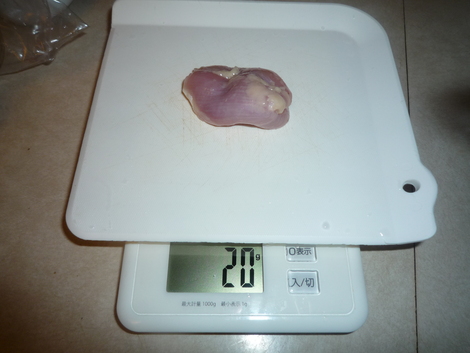
Mix the ingredients of the marinade. You don’t need a lot.
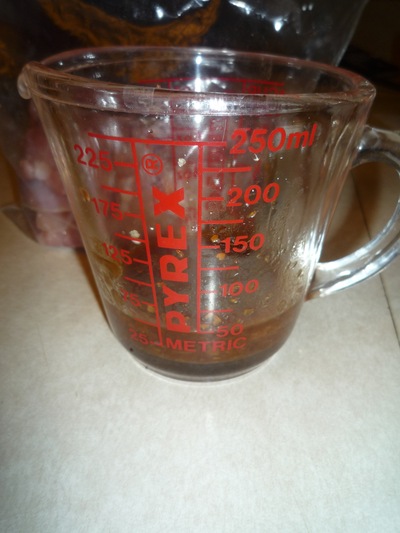
Marinate for no more than 30 minutes. If it marinates too long, it won’t be crispy.
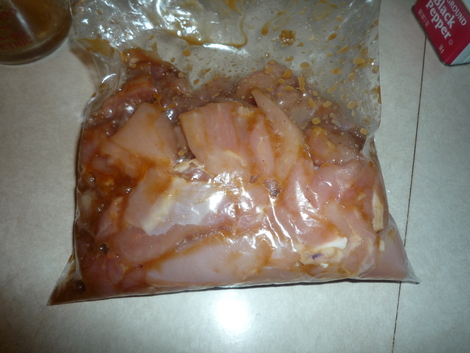
Add the katakuriko and mix well again.
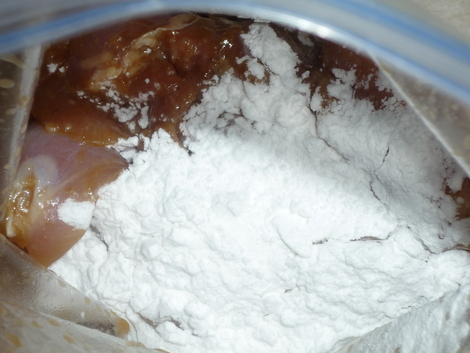
Empty everything onto a plate before deep frying. It’s easier than trying to get it out of the plastic bag.
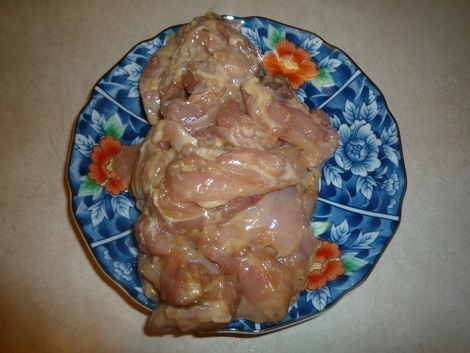
The temperature should be 180 C or about 356 F. It’s not quite hot enough…why am I holding the chicken over it?
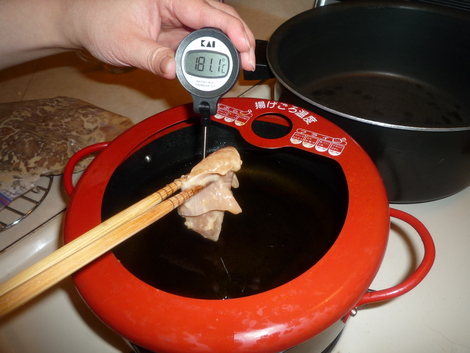
Deep fry the karaage the first time for 2 minutes.
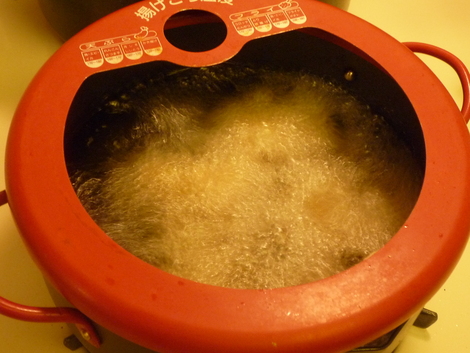
After the first deep fry, the chicken should be a light golden color. Let it rest for 4 minutes.
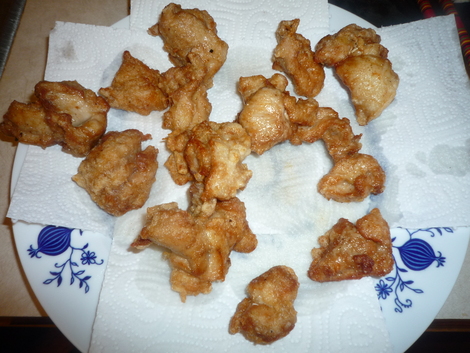
Deep fry the second time for 1 minute. After the second time, it will be a golden color and be crispy on the outside and juicy on the the inside.
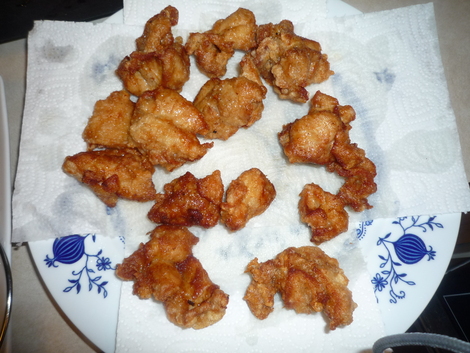
Serve with Japanese-style potato salad and garnish with lemon and cherry tomatoes. This chicken got a little over cooked but the garnish was perfect.
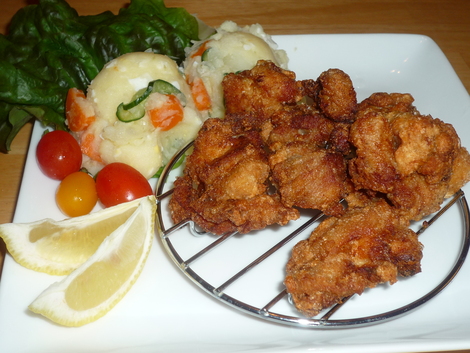
I think the oil temperature fell too much and it didn’t get crispy enough.
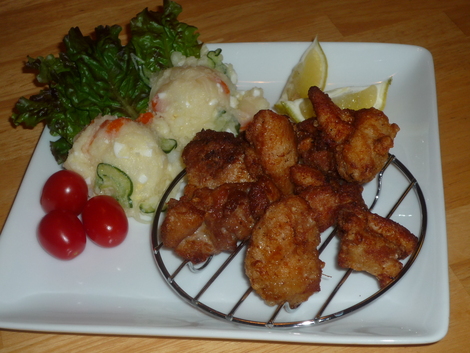
The third time is a charm and the chicken was just perfect, but I ran out of cherry tomatoes and the garnish is a little sloppy.
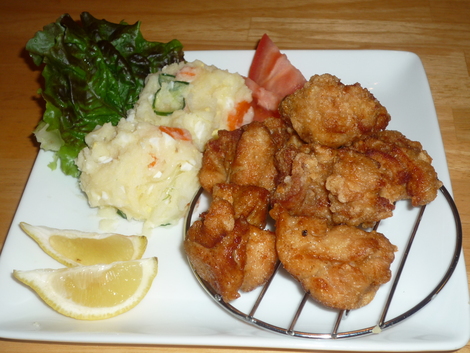
By the way, although karaage is a very Japanese dish, the “kara” kanji for karaage means Tang Dynasty. Hmmm any guesses?
umamitopia.com: Authentic Japanese, CA fusion, French & Italian influenced recipes.

Naomi Kuwabara was born and raised in California but spent many summers in Japan growing up. She has spent time living in Hokkaido and Osaka, both meccas for Japanese cuisine. Her passion is cooking and sharing her experiences cooking Japanese food with others. Her blog Umamitopia is about her experiences cooking Japanese food. Her greatest inspirations are from her mother and grandmother. Her cooking adventures can be found at http://umamitopia.com.

